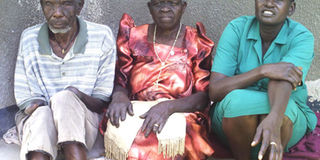Prime
Abandoned at the hospital because they had leprosy

Hellen Tita (right), a social worker, with Lawrence Ocupo and Margaret Malongo who met at the leprosy centre and got married. Photo by Richard Otim.
What you need to know:
When they were afflicted by leprosy, they were rejected by their communities. Upon receiving treatment at the hospital and getting better, they still were not accepted back. Now the hospital is the only home they know.
Lawrence Ocupo, 80, has lived at the Leprosy Rehabilitation Centre in Kumi for almost 30 years because his relatives are reluctant to receive him back.
In 1979 he lost his sight and can only recognise people by their voices. This has made it harder for him as he cannot trace his way back to his village.
“My relatives are reluctant to receive me. I have no children and had never married. My sister is dead and her children have refused to take me back,” said Ocupo. “I have nowhere to go.”
Looked at as a curse
He has lost all his fingers and toes and only feeds with the help of an attendant—a burden that perhaps his relatives feared to shoulder. He is one of the 22 lepers who have failed to reunite with their families because of their fear that they could become infected with leprosy. The disease is regarded as a curse by many communities in Teso.
Ocupo, who has lived at the leprosy centre since 1985, had not been married until 2000 when he met Margaret Malongo, who is also a leper. She hails from Buta village, Bulago Sub County in Manafwa District but now stays at Kumi leprosy centre.
Among the Bagisu, there are a number of taboos associated with leprosy. Forty years ago her own relatives threatened to kill her if she insisted on remaining in the village.
“A mulokole (born again Christian) who offered to keep me at his home was also attacked. They threatened to burn his home if he did not send me away,” Malongo recalled.
She had just got married to a village mate when a skin infection symptomatic of leprosy developed on her arm. When she went to hospital for a check up, it was discovered the disease had gotten into her blood stream.
Like other lepers who have since turned out to be permanent residents at Kumi leprosy centre, Ocupo and Malongo have no hope of going back to where they came from. “I tried to return to my people but they threatened to kill me. The whole village turned against me that I was going to infect them with the disease. I could not share anything even with my own relatives,” said Malongo.
Little knowledge
Although the disease is curable—and once attended to early does not develop into serious complications—much of the stigma against leprosy victims is because of little knowledge about the infection. “I cannot get back (either) to my husband’s home. He also rejected me and got another woman. I have nowhere to go and this is my home. I will die here,” Malongo added.
Ms Hellen Tita, one of the social workers at the centre, said Ocupo and Malongo met there and have got married. “She is the one taking care of him now and had also received treatment here before. She tried to get back to her family but the relatives rejected her,” she said.
Taking care of the lepers at the centre is eating into the meagre resources allocated to the hospital. The medical superintendent, Dr Ruth Obaikol, points out that most of the time the centre has been operating dependent on donor support.
Permanent residents
Treatment of the disease has been made much easier with discovery of more effective drugs comprising a combination of Rifampicin, Clofazimine and Dapsone drugs administered for 12 months in the case of acute infection.
“It cures patients and reduces serious infection and thereby interrupts transmission of the disease,” Dr Obaikol said, adding that the therapy also prevents disabilities through early cure.
The lepers, now permanent residents at the hospital, are provided with feeding, medication and shelter.
For those who pass on before getting back to their homes, the hospital takes care of the burial requirements. With support from The Leprosy Mission International, the lepers have been helped to cope with the stigma.
But such support no longer comes. According to the hospital registry, at least 20 new cases of leprosy from various parts of Teso and neighbouring regions have been diagnosed since 2011.
“Many of the cases that we have received are at advanced stage. If discovered early, the disease can be treated without causing any deformities,” said Dr Obaikol.
The hospital is now stuck with the permanently resident lepers who have no hopes of going back to their homes. These are elderly patients who have been receiving medication and rehabilitation at the hospital and have stayed at the facility for over 40 years.
Kumi hospital administrator, Charles Okula says, “Some of the old people (stuck at the hospital) have stayed here for many years. They have been rejected by their relatives and we have a big challenge of maintaining them at the hospital.”
Constraints
The hospital, which specialises in leprosy treatment, mainly depends on donor aid to support the lepers but is currently faced with financial constraints and cannot adequately help the patients.
The centre is a zonal facility which serves Acholi, Lango, West Nile, Teso, Bugisu and Karamoja regions. There are currently 40 leprosy patients at the hospital.
Enos Ocaatum, 80, a leprosy patient, has lived at the hospital for most of his adult life. Three years ago, he had attempted to trace his relatives back at Malera in Bukedea District where he was born but was not able to find any of them and now is back at the leprosy centre.
The leprosy control officer attached to Kumi hospital, Mr Bernard Anthony Akol, said the facility is overstretched and cannot provide adequate support to those patients permanently residing at the centre.
The leprosy patients have since found solace at the Kumi Leprosy Centre established by Church Missionary Society in 1929 in response to the need for specialised work among leprosy patients in Teso and the neighbouring regions.
Iteso Cultural Union member, Ms Frances Akello, said the disease especially in the earlier days was very much feared because it was considered a curse and whoever contracted it would be ostracised from the community.
Anybody who would show signs of the disease was never allowed to fetch water from communal wells. If found, the most severe punishment would be administered on the leper.
Though Akello says the situation is a bit better now for the lepers, the cases of the patients remaining at the hospital even after they have been treated shows the stigmatisation and cultural beliefs persist.




